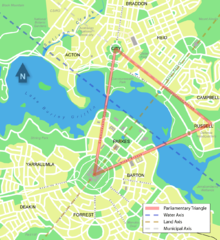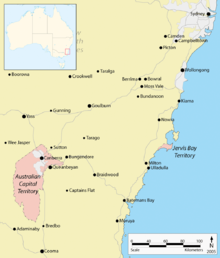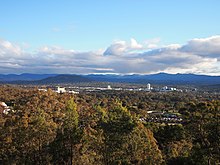Canberra
![]()
This article is about the city of Canberra in Australia; for other meanings of the same name, see Canberra (disambiguation).
Canberra (![]()
![]() [ˈkænbɹə]) is the capital and eighth largest city of Australia. The largest inland city, it is located in the Australian Capital Territory (ACT), 248 km southwest of Sydney and 654 km northeast of Melbourne. The plan capital city of Canberra was designated in 1908 as a compromise solution due to the rivalry between Melbourne and Sydney. After an international urban design competition, the Australian Federal Government chose the design of American architects Walter Burley Griffin and Marion Mahony Griffin. Construction work began a few weeks before the official founding of the city on 13 March 1913, and Canberra was granted capital status on 9 May 1927.
[ˈkænbɹə]) is the capital and eighth largest city of Australia. The largest inland city, it is located in the Australian Capital Territory (ACT), 248 km southwest of Sydney and 654 km northeast of Melbourne. The plan capital city of Canberra was designated in 1908 as a compromise solution due to the rivalry between Melbourne and Sydney. After an international urban design competition, the Australian Federal Government chose the design of American architects Walter Burley Griffin and Marion Mahony Griffin. Construction work began a few weeks before the official founding of the city on 13 March 1913, and Canberra was granted capital status on 9 May 1927.
The structure of the town centre is based on geometric motifs such as circles, hexagons and triangles. It is aligned on axes based on topographical landmarks in the ACT, notably the reservoir Lake Burley Griffin. The design of the city is influenced by the principles of the Garden City movement and incorporates significant areas of natural vegetation. While the city's development was significantly slowed by World War I and the Great Depression, strong population growth began after World War II and continues to this day. As the capital city, Canberra is the seat of the constitutional organs of the Australian state along with its ministries, administrations and courts. These generate the majority of the gross national product and are also the largest employer. In addition, numerous social, scientific and cultural institutions of national importance have their headquarters in Canberra.
Canberra does not have a city council or its own municipal government like other Australian cities. The Australian Capital Territory Legislative Assembly performs the role of both a city council for Canberra and a territorial government for the rest of the Capital Territory. The vast majority of the Territory's population resides in Canberra itself, so the city is nevertheless the main focus of Territorial government activity. The federal government retains authority over the territory and can repeal local laws. Through the National Capital Authority, it continues to exert great influence over planning decisions in the city.
Geography
Canberra covers an area of 814.2 km² and is located just east of the Brindabella Range, part of the Snowy Mountains, about 150 km from Australia's east coast. The urban area, which is about a quarter of the area of the Australian Capital Territory (ACT), is located in the north-eastern part of the ACT at an average elevation of 580 metres above sea level. The highest point is the top of Mount Majura hill at 888 metres. Other significant hills include Mount Taylor (856 m), Mount Ainslie (843 m), Black Mountain (812 m) and Mount Stromlo (770 m).
The Molonglo River divides the city into two roughly equal halves. This river is impounded by Scrivener Dam to form Lake Burley Griffin, a large body of water in the city center that reaches 11 km in length and up to 1.2 km in width. Until the lake was dammed, the Molonglo River caused occasional devastating floods. It empties into the Murrumbidgee River, a tributary of the Murray River, northwest of Canberra. Several smaller rivers in the city area or not far from it empty into the Molonglo or the Murrumbidgee. These include the Queanbeyan River, the Cotter River, Jerrabomberra Creek and Yarralumla Creek. Ginninderra Creek and Tuggeranong Creek are dammed to form Lake Ginninderra and Lake Tuggeranong respectively.
The surrounding bushland is now a mixture of savannahs, shrublands, swamps and dry forests, a significant portion of which are combined in the Canberra Nature Park. The native forest in the region, which was once almost entirely eucalypt, served as a fuel and timber resource. Forestry began in 1915 with trials on a range of species including Pinus radiata on the slopes of Mount Stromlo. By the early 1960s, logging had decimated the eucalyptus, and water quality concerns led to the closure of the forests. Since then, plantations have expanded, with the benefit of reducing erosion in the Cotter River watershed. Today, the forests are popular recreational areas.
The population of the ACT lives almost exclusively in Canberra. In the rural part of the ACT there are only a few homesteads and villages with a combined population of just over 5000. The largest settlements are Williamsdale, Naas, Uriarra Village, Tharwa and Hall. Ten kilometres southeast of the city centre, just on the border of the ACT, is the New South Wales state town of Queanbeyan, with a population of around 36,000.
Climate
Canberra has a temperate oceanic climate (effective climate classification: Cfb). Due to the altitude and distance from the coast, there are four distinct seasons, but the climate is drier than in coastal cities. This is due to the city's location in the rain shadow of the Brindabella Range. The climate is characterized by hot to warm, dry summers and (by Australian standards) cool to cold winters with dense fog and frequent frost.
The highest temperature ever recorded was 44.0 °C on 4 January 2020, and three days earlier Canberra measured the worst air quality index of any major city in the world. Both were consequences of the devastating bushfires in Australia in 2019/2020 and the associated heavy smoke development.
The lowest temperature ever measured was -10.0 °C on 11 July 1971. Snow falls on average once or twice a year, but the amount is small and always melts again after a short time. Thunderstorms can occur between October and March, and most rain falls in spring and summer. Generally, the wind does not blow very strongly. The following table shows the average climate values from 1981 to 2010:
| Canberra | ||||||||||||||||||||||||||||||||||||||||||||||||
| Climate diagram | ||||||||||||||||||||||||||||||||||||||||||||||||
| ||||||||||||||||||||||||||||||||||||||||||||||||
| Monthly average temperatures and precipitation for Canberra
Source: Australian Bureau of Meteorology: Canberra Airport Station. Observation period: 1939-2010. Retrieved 27 December 2013. | |||||||||||||||||||||||||||||||||||||||||||||||||||||||||||||||||||||||||||||||||||||||||||||||||||||||||||||||||||||||||||||||||||||||||||||||||||||||||||||||||||||||||||||||||||||||||||||||||||||||||||||||||||||||||||||||||||||||||||||||||||||||||||||||||||||||||||
Geometry of the city center
Canberra is a planned city, with the downtown area originally designed by American architect Walter Burley Griffin (assisted by his wife Marion Mahony Griffin). In the city centre on both sides of Lake Burley Griffin's main streets follow a wheel-and-spoke pattern rather than a grid. Griffin's urban design features an abundance of geometric forms, including concentric hexagonal and octagonal street patterns radiating from multiple radii. The city's later outlying districts, on the other hand, are not geometrically structured.
Lake Burley Griffin has been deliberately designed to relate its orientation to various topographical landmarks in Canberra. A 'land axis' perpendicular to the Central Basin extends from Capital Hill - the site of the new Parliament House - north-northeast across the north shore and along the prestigious ANZAC Parade to the Australian War Memorial at the foot of Mount Ainslie. At the south-western end of the land axis rises Bimberi Peak, the highest mountain in the Australian Capital Territory, about 52 km south-west of Canberra in the Brindabella Range.
The chord of the circular segment that forms the central basin of Lake Burley Griffin is perpendicular to the land axis and is called the "water axis". It extends northwest toward Black Mountain. A line parallel to the water axis on the north side of the city forms the "municipal axis". It corresponds to the course of Constitution Avenue, which connects City Hill in the Civic Centre business district with the Market Centre and the Ministry of Defence on Russell Hill. Commonwealth Avenue and Kings Avenue run from Capital Hill in the south to City Hill and the Market Centre in the north respectively, forming the western and eastern edges of the central basin. The area enclosed by the three streets is called the Parliamentary Triangle; this equilateral triangle forms the heart of Griffin's urban design.
The Griffin couple assigned spiritual values to Mount Ainslie, Black Mountain, and Red Hill, and originally planned to plant each of these hills with flowers. In this way, each hill was to be covered with a single, primary color representing its spiritual value. This part of her plan never came to fruition, as World War I slowed the construction of the capital and planning disputes led to Griffin's dismissal by Prime Minister Billy Hughes at the end of the war.
Urban structure
Canberra's urban areas are hierarchically structured. There are seven wards, each of which is subdivided into smaller neighbourhoods known as 'suburbs', regardless of location. Virtually all of these suburbs in turn have a district centre as a focus of commercial and social activity. The boroughs were settled in this order:
- Canberra Central (comprising North Canberra and South Canberra), largely in the 1920s and 1930s, expansion into the 1960s, 25 neighbourhoods.
- Woden Valley, as of 1964, 12 neighborhoods.
- Belconnen, as of 1966, 27 neighborhoods (two of which are not yet developed).
- Weston Creek, as of 1969, 8 neighborhoods.
- Tuggeranong, as of 1974, 18 districts
- Gungahlin, as of 1993, 18 districts (three of which have not yet been developed)
- Molonglo Valley, from 2010, 13 districts planned
Canberra Central largely follows Griffin's plans. In 1967, the National Capital Development Commission adopted a new superstructure plan, the "Y-Plan". Since then, further urban development has been based on a series of shopping and commercial zones linked by expressways, known as town centres. The layout of these centres resembles the shape of the letter Y. Tuggeranong forms the lower end, while Belconnen and Gungahlin are at the ends of the arms of the Y. Urban development is strictly regulated, partly by town planning measures and partly by restrictive use regulations for parcels of land. The federal government leased all land in the Australian Capital Territory for a period of 99 years, although the Territory government now administers most leases itself. Since the beginning of the 21st century, there have been persistent calls for a relaxation of planning guidelines.
Most neighborhoods have smaller stores and are located near a larger shopping center that serves several neighborhoods. Public facilities and schools are often located near these shops or shopping centres. Many neighbourhoods are named after famous Australians and early settlers or after Aboriginal names. Street names usually follow a particular pattern; for example, streets in Duffy are named after Australian dams, those in Page after biologists and naturalists. Fyshwick, Mitchell and Hume each have a light industry zone. Foreign missions are concentrated in the districts of Yarralumla, Deakin and O'Malley.

enlarge and show information about the picture
![]()
Panorama of Canberra and Lake Burley Griffin, taken from Black Mountain Tower

The centre of Canberra, the axes and the Parliamentary Triangle are well visible

Location Canberra in Australia

Recording of the spot satellite

View of Woden Valley

View of Tuggeranong
Population
| Population trends | |
| Year | Inhabitants |
| 1911 | 1777 |
| 1921 | 2583 |
| 1933 | 8947 |
| 1947 | 16.905 |
| 1961 | 58.828 |
| 1966 | 96.013 |
| 1971 | 151.169 |
| 1976 | 207.740 |
| 1981 | 227.581 |
| 1986 | 258.910 |
| 1991 | 289.320 |
| 1996 | 308.251 |
| 2001 | 307.053 |
| 2006 | 322.036 |
| 2011 | 357.222 |
| 2016 | 395.790 |
In 2016, Canberra had a population of 395,790, which equates to a population density of 491 inhabitants/km². The 2016 census found that 1.6% of the population were Aboriginal or Torres Strait Islander and 32.1% were born outside Australia. Most of the foreign-born were from English-speaking countries, led by the United Kingdom at 3.2% and followed by the People's Republic of China (excluding Special Administrative Regions and Taiwan) at 2.9%. India accounted for 2.6% of the population, with another 1.2% born in New Zealand. Since the beginning of the 21st century, the number of immigrants from East and South Asia has increased sharply. Most residents, 72.7%, speak only English at home; the most common foreign languages are Mandarin (3.1%), Vietnamese (1.1%), Cantonese (1.0%), Hindi (0.9%), and Spanish (0.8%).
Compared to other Australian cities, Canberra's population is younger, more mobile and better educated. The average age is 35, with only 12.7% older than 65. Between 1996 and 2001, 61.9% of residents either moved here or left. In May 2017, 43% of 25-64 year olds had an educational qualification equivalent to at least a bachelor's degree, strikingly higher than the national average of 31%.
50% of Canberra residents reported Christianity as their faith in the 2016 Census; the most common denominations are Roman Catholic (22.3%) and Anglican Church of Australia (10.7%). Other religions include Buddhism (2.0%), Islam (1.1%), Hinduism (0.7%), Judaism (0.2%) and 'other' (0.6%). A total of 36.2% of respondents described themselves as non-denominational. The Catholic Archdiocese of Canberra-Goulburn reports directly to the Holy See, while the Anglican Diocese of Canberra & Goulburn is part of the Ecclesiastical Province of New South Wales.
Questions and Answers
Q: What is the population of Canberra?
A: There are 403,468 people who live in Canberra.
Q: When was Canberra founded?
A: Canberra was started in 1913.
Q: Who won the competition to design the new capital city of Australia?
A: An architect from Chicago named Walter Burley Griffin won the competition to design the new capital city of Australia.
Q: How big is Canberra compared to Berlin?
A: Canberra has a size in area nearly as big as Berlin, but the number of people who live there is much smaller.
Q: What type of climate does Canberra have?
A: Canberra has an oceanic climate (Cfb in the Köppen climate classification).
Q: What are some famous sights tourists come to visit when they go to Canberra?
A: Some places to visit are the Government House, Parliament House, the High Court of Australia, the Australian War Memorial, the National Gallery of Australia, the Royal Australian Mint, Telstra Tower,the National Library of Australia andthe National Museum of Australia.
Search within the encyclopedia